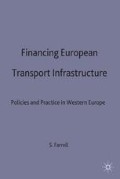Abstract
Around two-thirds of Europe’s population lives in towns with over 50 000 population, yet investment in public transport infrastructure is small, less than 10 per cent of total transport infrastructure investment. There are several reasons for this, including the small proportion of of public transport requiring reserved track, the sharing of rail track between suburban and long-distance services and the controversial nature of many new projects.
Access this chapter
Tax calculation will be finalised at checkout
Purchases are for personal use only
Preview
Unable to display preview. Download preview PDF.
Notes
Halcrow Fox, A Study into the Organisation and Operation of Urban Public Transport in the 12 Member States ( Brussels: EC DG VII, 1993 ).
H. Hondus, ‘How can Tramways and Light Rail be Made More Readily Affordable?’ Public Transport International, No. 3 (1995), 71–7.
C. Quin, M. Houée and A Méyère, Le Financement des Transports Collectifs Urbains dans les Pays Développés ( Paris: Ministère de l’Equipement, des Transports et de la Mer, 1990 ).
P. Hall and C. Hass-Klau, Can Rail Serve the City? ( Farnborough: Gower, 1985 ).
B. Simpson, City Centre Planning and Public Transport: Case Studies from Britain, West Germany and France (Van Nostrand Reinhold, 1988).
E. Bieber, ‘Regionalisation of Public Transport in Germany: Rhein-Main Pilot Study’, European Transport Forum Annual Summer Meeting Seminar C 1996 ( London: PTRC, 1996 ).
N. Caltot, ‘Modalités de Gestion du Service Public des Transport Urbains’, Administration No. 168 (July 1995), 28–30.
M. Mathieu and B. Canepa, Les Transports Collectifs pour Libérer la Ville, ( Noisiel: Les Presses du Management, 1992 ).
A. Bonnafous, Transports: Le Prix d’une Stratégie ( Paris: Commissariat Général du Plan, 1995 ).
H. Cuq and D. Bussereau, Une Nouvelle Donne pour la SNCF ( Paris: Assemblé National, 1994 ).
Ministère de l’Equipement, du Logement, des Transports et du Tourisme, Urban Public Transport in France ( Paris: MELTT, 1994 ).
E. Minivielle, ‘Le Financement des Transports Collectifs Urbains de Province depuis 1975’, Notes de Synthèse: Transport Urbain (Paris: OEST, 1994 ).
Author information
Authors and Affiliations
Copyright information
© 1999 Sheila Farrell
About this chapter
Cite this chapter
Farrell, S. (1999). Urban public transport. In: Financing European Transport Infrastructure. Palgrave Macmillan, London. https://doi.org/10.1057/9780230502291_5
Download citation
DOI: https://doi.org/10.1057/9780230502291_5
Publisher Name: Palgrave Macmillan, London
Print ISBN: 978-1-349-40413-1
Online ISBN: 978-0-230-50229-1
eBook Packages: Palgrave Economics & Finance CollectionEconomics and Finance (R0)

